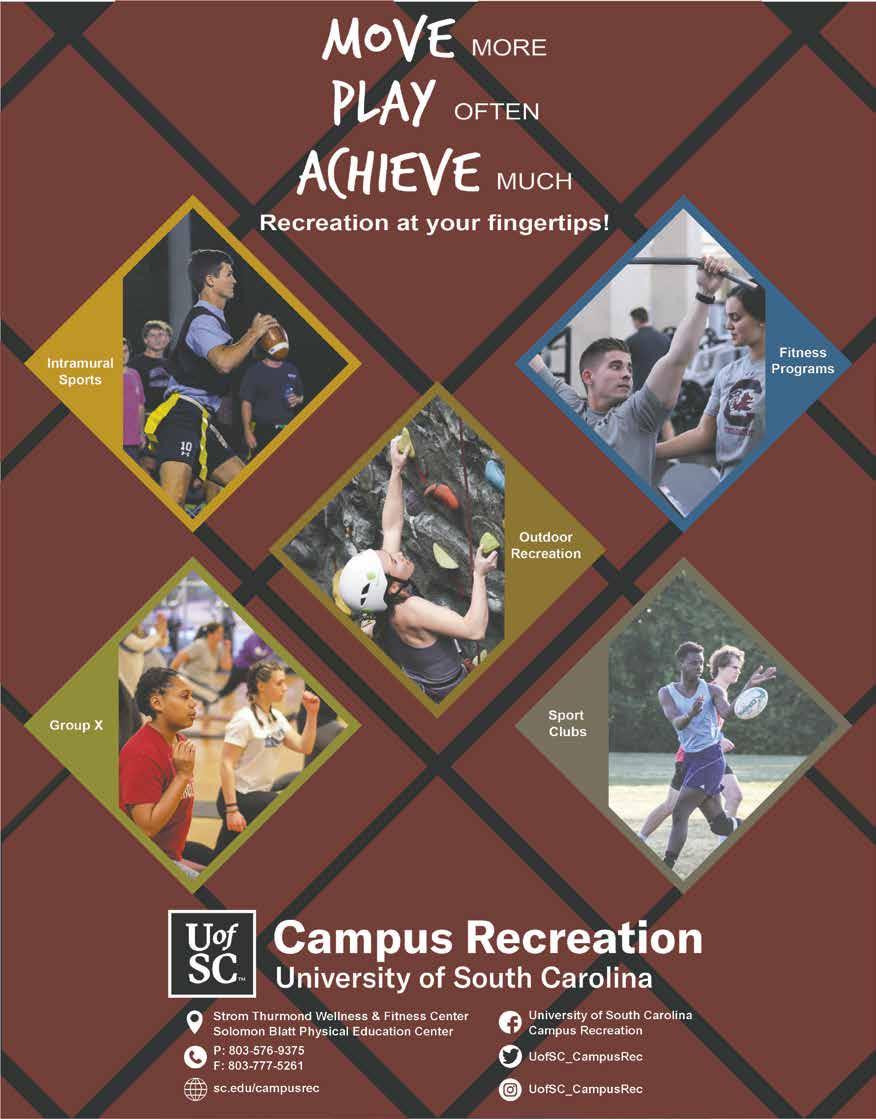MOMENTUM OF DENIM
NEW TRICKS FOR RETRO FITS
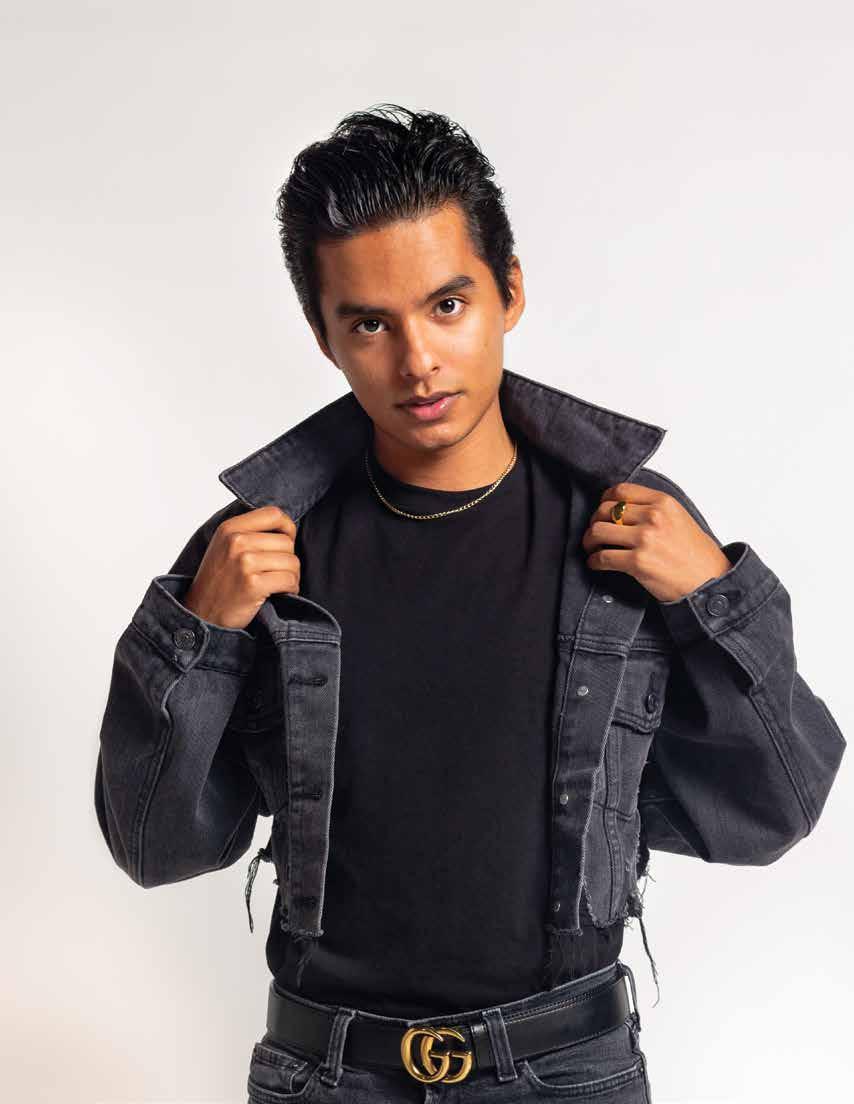
WAITING IN THE DARK
THE LASER ART INSTALLATION THAT NEVER MATERIALIZED
THE FINAL FRONTIER
THE FUTURE OF SPACE TRAVEL IS FEMALE
SEEING STARS
WHY ARE MILLENNIALS SO INTO ASTROLOGY?

MOMENTUM OF DENIM
NEW TRICKS FOR RETRO FITS

WAITING IN THE DARK
THE LASER ART INSTALLATION THAT NEVER MATERIALIZED
THE FINAL FRONTIER
THE FUTURE OF SPACE TRAVEL IS FEMALE
SEEING STARS
WHY ARE MILLENNIALS SO INTO ASTROLOGY?
1 Annual Percentage Yield of 5.38% is accurate as of October 1, 2019. The APY may change after the account is opened. No minimum balance is required to open the account or earn the advertised APY. Fees may reduce earnings. Deposits can only be made by FFCU through qualifying or enrolling in a Loyalty Account Program, and members may receive a 1099-MISC for qualifying Loyalty Select deposits.
2 Only Checking Accounts that have the option to receive a Debit Card qualify for the Edge Up program and all account types may not be eligible. ATM or cash back purchases, Debit Card credits, checks, ACH, disputed transactions and other non-Debit Card transactions may not qualify. The Credit Union reserves the right to cancel or modify the Edge Up program at any time. For a complete list of terms, conditions and qualifications, please call 1-800-8451614, visit an office or log in to Founders Online.
3 All account types may not be eligible for the Dividend Amp program. By enrolling, all suffixes under the selected account number are enrolled, except for IRA Share Certificates which are not eligible. The Credit Union reserves the right to cancel or modify the Dividend Amp program at any time. For a complete list of terms, conditions and qualifications, please call 1-800-845-1614, visit an office or go to Founders Online.
4 Not all Credit Card types are eligible for the Cash In program. Only members with a Founders Credit Card that accrues points are eligible. The minimum redemption amount is $25. Point requirements assigned to any award are subject to change without notice, and awards may be discontinued or substituted at any time. Points redeemed are non-refundable. The Credit Union reserves the right to cancel or modify the Cash In program at any time. For a complete list of terms, conditions and qualifications, please log in to Founders Online.
1Requires credit evaluation. Teens under the age of 18 are required to have an adult sign as joint owner. Accounts without eStatements will be charged $2 for periodic statements by mail.
STUDENT MAGAZINE OF THE UNIVERSITY OF SOUTH CAROLINA
EDITOR-IN-CHIEF
CREATIVE DIRECTOR MANAGING EDITOR
PRINT ARTICLES EDITOR Liz Smith
DIGITAL ARTICLES EDITOR Hallie Hayes
ASSISTANT ARTICLES EDITOR Caroline Fairey
STAFF WRITER Dabriel Zimmerman
STAFF WRITER Cassidy Spencer
STAFF WRITER Nicole Kitchens
STAFF WRITER Jessica Fields
STAFF WRITER Madison Bridges
COPY CHIEF Cassidy Spencer
ART DIRECTOR Emily Schoonover
STAFF DESIGNER Olivia Griffin
STAFF DESIGNER Meagan Horres
STAFF DESIGNER Alizajane Hicks
PRINT PHOTO EDITOR Mark Maddaloni
DIGITAL PHOTO EDITOR Coleman Rojahn
PRINT PHOTOGRAPHER Nancy Sterrett
PRINT PHOTOGRAPHER Camila Trujillo
PRINT PHOTOGRAPHER Alyssa-Leigh Willey
PRINT PHOTOGRAPHER Zhané Bradley
PRINT PHOTOGRAPHER Alexander Wyatt
PRINT PHOTOGRAPHER Alyssa Rasp
PRINT STYLE EDITOR Jasmine White
DIGITAL STYLE EDITOR Parker Blackburn
ASSISTANT STYLE EDITOR Malachi Harris
ASSISTANT STYLE EDITOR Vittoria Gallello
PUBLIC RELATIONS DIRECTOR Alyssa-Leigh Willey
MULTIMEDIA DIRECTOR Megan Edgemond
SOCIAL MEDIA COORDINATOR Jordan Postal
MARY-BRYANT CHARLES
MEREDITH PRICE
CHRISTIAN COMPTON
DIRECTOR OF STUDENT MEDIA
Sarah Scarborough
ASSISTANT DIRECTOR OF STUDENT MEDIA
Sydney Patterson
ADVERTISING MANAGER
Patrick DiDomenico
FACULTY ADVISOR
Scott Farrand
CREATIVE SERVICES
Emily Schoonover
Meagen Sigmon
Abby Meyer
Julia Linthicum
Molly Collins
Meredith Price
ADVERTISING REPRESENTATIVES
Lauren Busman
Barron Coleman
Glenn Johnson
Brittany Harrelson
Emily McLendon
Victoria Powers
Silvia Ramirez
Ariel Whitmire
Advertising: (803) 777-3018
To contact G&B, email sagandbe@mailbox.sc.edu or visit www.gandbmagazine.com
Garnet & Black magazine is produced four times a year by students of the University of South Carolina and is distributed free to members of the university community. All editors and staff members can be contacted at (803) 777-1149. The office is located in Russell House room 339.




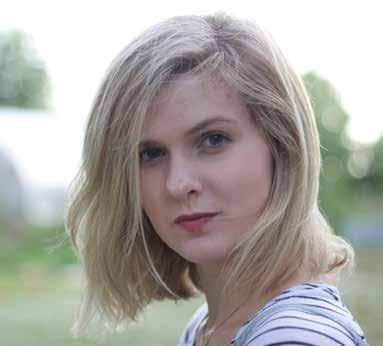
I’m not going to lie, USC, it’s been rough.
I can officially say I’ve hit that time of year™, the time when I’m tired and stressed all the time, when my favorite music and foods don’t energize me the way they usually do, when it’s hard to find any reason to get out of bed other than it’s one step closer to being able to go back to bed. And all the time, that dark little voice in my brain loves to point out how it doesn’t make sense.
Just a few months ago, it was summer and I was wishing every minute away, so ready to be exactly where I am now. I’m taking classes I love. I’ve got my dream job working with my dream team of people. But still, I find myself sinking.
And I know I’m not alone. I know we’re all knee-deep in our own tough spots, which is why I wanted to talk to y’all about it. It’s important to be able to face things, to just grit your teeth get it all dealt with because sometimes it really do be like that, but sometimes we need more. We need each other.
The best I’ve felt in months was when I sat down to edit these articles. The feeling came back a few days later, sitting in our offices with the design team, watching them take the amazing work of our writers and photographers and stitch it all together into a magazine. This is always what happens when we get together. The passion and creativity this staff puts into their work is infectious. When I leave a meeting with them, when I see what they make, I stand taller. I feel surer.
Sometimes the best way to derive a sense of purpose for yourself is through others. Through support, through collaboration, through just being there. It’s by no means a cure-all. I’m still stressed and tired and second-guessing myself even writing this letter, but none of that matters. What matters is what you’ll find on the next page.
An hour in the life of writer James D. McCallister reveals ultimate success is not national acclaim, a published series, or a professorial gig, but a soul that has learned to love the process of writing alongside the product. This is a soul that is remembered and remembers in turn, an observation confirmed by the happenstance reunion that I witnessed between the author and an old friend during a conversation at Drip Coffee.
Friend: It’s been a really long time. I can’t believe you even recognize me.
I did! And you wrote a book!
I did! I knew you when you were just a girl
James: I do! Jessica. I thought you moved away?
Yeah, back when I was skipping school to hang out at Loose Lucy’s.
That’s right, and when I was writing behind the cash register. When I was trying to be a ‘writer’.
The Five-Points based author graduated from the University of South Carolina all the way back in the 1970s. Before he ever wrote, James “fell in love with reading” as an only child growing up in rural South Carolina. By the time he was in high school, he and his friends were contacting the arts commission with movie scripts that they had written.
“I was besotted with movies and the possibilities,” James mentioned, eyes sinking over the brim of his coffee cup. From there, his literary path detoured for about fifteen years in which he encountered both life-changing peaks and the pits of human existence. He describes his life as “a series of innocence ripped away,” but a journey nonetheless that lead him to, in the words of Bob Dylan, “paint [his] own masterpiece.”
Pursuit of that masterpiece settled him squarely into five years of revision after revision, daily discipline in craft, and a computer file of rejection letters longer than most writers would care to admit. Now, as the author of a trilogy whose last book is set to release this year from his personal indie press, McCallister shows off his rejections as proof that a young boy from a small town in South
Carolina can truly achieve his goals; if he can, then others can too.
South Carolina serves as the inspiration for that trilogy, entitled Dixiana. The narrative is set in the fictional South Carolinian county of Edgewater, located just outside of Columbia. Reading through the series may call to mind the day to day culture and locations of Columbia residents; Five Points even makes a cameo appearance under the name of the “Old Market.” The setting allows the books to explore cultural themes that James notices in Drip, on the street, or in Loose Lucy’s, a local store owned by him and his wife. At this point, Edgewater County is real to him, as real as Charleston, Sumter, or Greenville.
If there’s one thing that James recommends to young writers, it is to approach life with the understanding that there is never any other time than now. “You have to think of yourself as a writer,” James said, “and there are no famous writers anymore. Here’s the truth: many of us are writing for other writers at this point.” According to James, the ideal of getting the MFA, signing book deals, and jetting around the world for signings is a myth. What is concrete, what is tangible, what is real and breathes is the internal romanticization that if you believe you are a writer, then you are; and if you are a writer, then write. If you survive the discipline of the craft, then you are successful, regardless of who knows your name.
“McCallister shows off his rejections as proof that a young boy from a small town in South Carolina can truly achieve his goals; if he can, then others can too.”

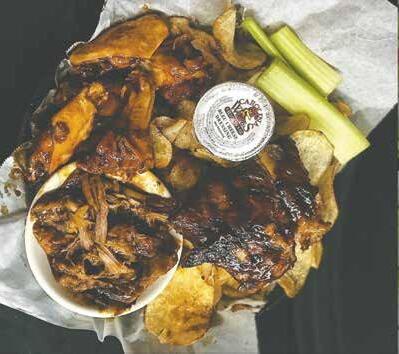
Warning signs of suicidal thoughts include:
• Withdrawing from social contact
• Increased substance use
• Engaging in self-destructive or risky behavior
• Aquiring the means for self-harm
• Statements like “I wish I were dead” or “I wish I’d never been born”
• Giving away belongings or saying
If someone reaches out to you about suicide, always take it seriously
According to the American Foundation for Suicide Prevention, between 50 percent and 75 percent of people who attempt suicide talk about their suicidal thoughts, feelings and plans before the act.
While social support is vitally important in this situation, you should not try to handle the situation on your own.
If you suspect someone is thinking of suicide, ask directly
• Are you thinking of suicide?
• Do you have the means or a plan to take your life?
If there is immediate risk, call 911 or use the RAVE Guardian app
Student Health Services - located behind the Russell House
Reach out to the National Suicide Prevention Lifeline at 800-273-8255.
“I just overheard a friend say their life is never going to get better... ”

My first introduction to space travel was in Zenon: Z3 when Zenon Kar saved Earth from the moon goddess, Selena. Ever since, I’ve been sort of obsessed with space travel, but astrophysics just doesn’t do it for me. You probably already know the basic hazards—no oxygen, no gravity and no way to grow food. This is all before you even get to the moon—past the moon is where things start to get crazy. So you can imagine the journey to Mars to be a bumpy one.

Putting a human on Mars comes with a whole host of problems. Some technological, some temporal—but the most important having to do with all of the variables that come with having humans in space. Astronauts would have to spend between six to eight months confined to the spaceship, leading to mental problems from isolation and confinement. Group dynamics become strained, signaling the first rumblings of the chaos volcano erupting.
But the astronauts don’t just have to deal with tense interactions with coworkers, they have to deal with their brains fighting back against the galaxy. Once you escape Earth’s gravitational field, there is the danger of the “floating brain.” This is basically your brain being pushed up into the skull. Research here in South Carolina by Dr. Donna Roberts at MUSC showed that the brain shifted towards the top of the skull, leading to the “floating brain” phenomenon which has some serious repercussions, one important one being the loss of vision due to a vast increase in intracranial pressure, swelling the optic nerve.
Once you pass the moon, the galaxy is even less welcoming and a new foe awaits. The danger of cosmic radiation is less-known to the public, but presents one of the biggest hurdles for space travel. Cosmic radiation has a tremendous negative impact on the body, but its most visible effects are on the brain. Prolonged exposure would cause a dramatic decline in cognition, even leading up to dementia, not mentioning an increased risk for certain cancers.
New studies have shown that there might be a sliver of hope after all—not in putting a man on Mars, but possibly a woman.

Dr. Susanna Rosi’s lab at UC San Francisco found that the female mouse brain could be immune to the negative effects of cosmic radiation, which has implications for how humans would respond in this environment on the way to Mars. They studied mice after being exposed to simulated cosmic radiation and saw the male mice experience extreme declines in brain functioning. They had trouble interacting with other mice, identifying objects and saw a reduction in the number of neurotransmitter receptors and synaptic connections in the hippocampus—brain’s memory center. But the female mice were fine. They did not show any signs of cognitive decline, had no problems interacting or see a decline in connections or receptors.
Underlying female immunity to simulated cosmic radiation are the activity of the microglia, immunity cells in the brain that act to protect the brain from itself by eating dead neurons and other cellular debris. These cells have been shown to be fundamentally different between females and males and this is thought to be the reason why female mice showed immunity to cosmic radiation.
I talked with Dr. Susanna Rosi, the lab’s director, to understand the implications this finding could have on the future of space travel. Dr. Rosi explains that the microglia in the male brain are in an “proinflammatory state” so once the brain starts to get zapped by the cosmos, the cells go into overdrive resulting in a lot of unnecessary deletions, leading to cognitive decline. Whereas these cells are in a more protective state in the female brain and respond better, or are not susceptible to, the injuries caused from the radiation.
One could ask why this research in mice is important when considering how cosmic radiation could affect humans. But it is important to remember that you cannot test how cosmic radiation affects humans ethically. Studies on the effect of radiation on the body comes from studies of cancer patients undergoing chemo, but this is not the same type of radiation that astronauts would be exposed to. Dr. Rosi stresses that the only test for the effects of cosmic radiation is the real test, when we finally get a human on Mars. This research, however, is not the be-all and end-all. There are so many other factors that play a role in space travel so far into the galaxy, and cosmic radiation is only a piece of the puzzle. Dr. Rosi believes that it is important to consider as many factors as possible in this research and NASA has granted them the opportunity to continue their work to further understand the differences between the male and female brain; in addition to the effects of space travel overall on the brain. Going forward, they will test the compounding effects of social isolation, cosmic radiation and microgravity on the brain to build a risk assessment model for astronauts.
But the future is looking bright (and female). NASA’s 2017 class of astronauts was 40% female and if the female immunity theory holds true, these numbers could change. Because, as Dr. Rosi says going to Mars “is not a matter of if, is a matter of when.” And this research could answer the question of who will be the first person to step foot on Mars.

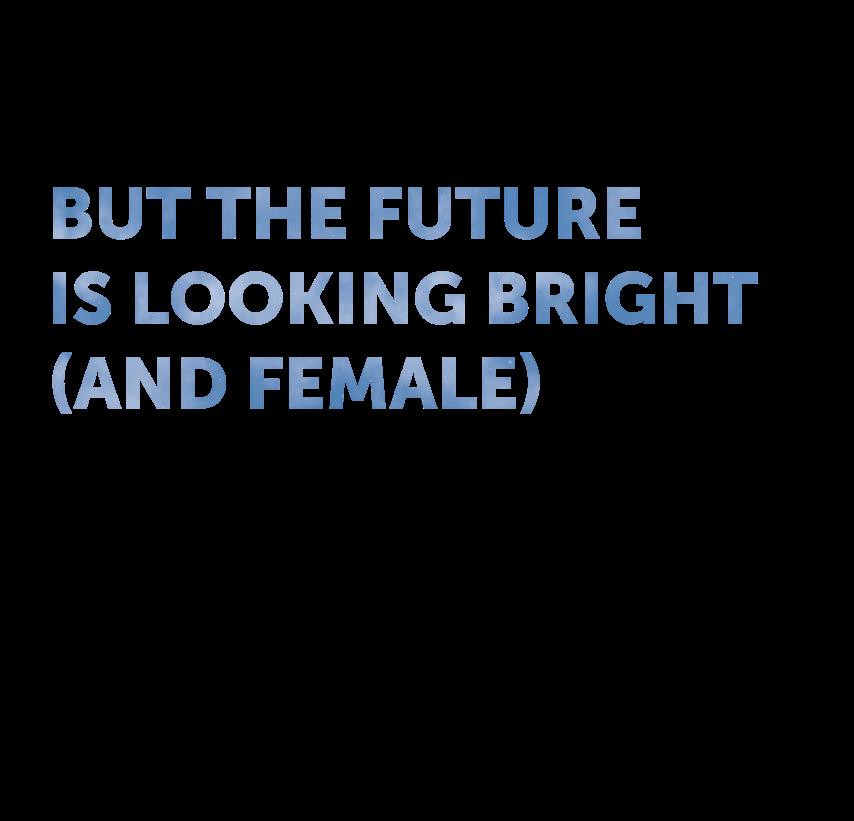

Ah, 2017. The year of the eclipse. It was August—the beginning of my sophomore year. Columbia was bristling with sweating tourists, every local business advertising with branded eclipse glasses, and life in Columbia was good—incredibly hot, unreasonably crowded, but good, nevertheless.
I had just started as the articles editor of this magazine; before school started, I interrupted my tranquil, Lowcountry summer to travel to the Garnet & Black office in Russell House to officially brainstorm the new articles list for my very first issue on staff. One of the articles I assigned myself had homework attached—a preview of a public laser art installation called “Southern Lights,” where for the first time, the 10-year exhibition would be turned on for the city to behold. Designed to be both technologically challenging and beautiful, “Southern Lights” would encompass multiple blue and green laser beams seen from the Blossom and Gervais Street bridges over the Congaree.
Although I interviewed Chris Robinson, the USC professor responsible for designing and implementing the installation, I never went to the preview. Instead, I spent the day forgetting any upcoming responsibilities, exploring the Riverwalk with my best friends, celebrating our new apartment and our new life surrounded by nature, wildlife, and winding paths, perfect for losing track of time. Little did I know—the preview would be the only time anyone got to see “Southern Lights.”
My article ended up being pushed back one issue, then two, then indefinitely put on hold as we waited for news of when the installation would actually debut. We had heard that it would be after the eclipse, but as
fall turned into winter, and winter into the new year, I began to worry. Back in Spring 2018, I emailed Professor Robinson once more, using such forward language that I, reading back over my wording, cringed slightly: “I cannot find any concrete information that the project will be completed over the summer. Could you point me in the right direction, or possibly give a timeline?” I never heard back.
Professor Robinson, at the time, and presumably still, knew more about laser art than most other people wandering the planet. Much more powerful than the lasers scanning groceries, these beams planned to traverse the Congaree are powerful, forward-moving, concentrated light that continues to travel if not met with impediment.
Laser becomes art when paired with an empty black sky, a rushing, dark river below, a crowd of trees muffling either bank as cars speed over the bridge. The blue and green beams were supposed to intersect and diverge, calling the viewer to examine their points of origin and their ultimate destination.
While some locals worried about the detriment to the more natural views of the Congaree, both Robinson and community sponsors such as the State Museum, OneColumbia, Richland County, and all three cities with claim to the Congaree (Columbia, West Columbia, and Cayce) maintained that the lasers (activated for three hours per night, weather permitting, for up to ten years, technology permitting) would enhance the nightly experience of the river, bringing together tourism and locals, nature and manmade art. Ultimately, however, no one ever got the chance to find out for themselves whether these
claims were true. Two years on, “Southern Lights” is nowhere to be seen.
Even at the time of the interview, before the first (and only) public exhibition of “Southern Lights,” Professor Robinson had reservations about the longevity of the project. “Unfortunately, laser light is extremely technically complex in this context and hard to manage beam stability. The laser tube has an average life of 10,000 hours. At three hours a night, that would be about ten years, but the environment here—heat, humidity, and afternoon and evening storms—make it very hard to keep the piece stable.”
Robinson’s comments on the nature of audience commentary also seem prescient in questioning why the piece never emerged: “Art often seems easy, but, like many things in reality, often isn’t. Everybody thinks they can paint like Pollock, but have never tried, and may not appreciate the implications.”
These implications seem to have put the piece indefinitely on hold. This retrospective article comes more than a year after the first round of creeping questions began to be publishing in South Carolina papers and news outlets. The State, the Free Times, and the Post & Courier all published pieces following up in 2018 about the progress of “Southern Lights.”
On June 6, 2018, the director of OneColumbia, Lee Snelgrove, spoke to the Post & Courier: “[Southern Lights] never really
stopped being a focus for us. We’ve been working with it the whole time. We are now at a point where Chris [Robinson], the artist, is turning them on some nights to make adjustments… I don’t really have a timeline right now for completion. ‘Soon’ is all I can say.”
But how soon is soon? Will the blue and green beams ever grace our riverbanks? As of this moment, Professor Robinson has moved to Beaufort and serves as the chair of the Visual Arts department at USCB; it’s unclear how committed he remains to a now two-year-stalled project. The website for “Southern Lights” still states “COMING 2018” and no updates have been issued from any of its sponsors.
It remains a mystery whether “Southern Lights” failed purely due to technology problems, logistics, or perhaps funding quarrels between the multitude of sponsors, all with varying levels of involvement in various city governments and non-profits. Public art is hard to mount support for, and even harder to justify to a budgetary committee—it’s unclear where the direct benefit to the citizen can be quantified.
But part of the sadness in never seeing “Southern Lights” is that art shouldn’t create a quantifiable experience. Professor Robinson had this to say, back in 2017, about the mystery of the intricate web of lasers he had drafted and dreamed for: “You cannot see it from any one place. Rather you must be curious, explore, and discover its secrets.”
Even in the absence of “Southern Lights,” I hope that you take the artist’s advice. Adventure into Columbia; spend long afternoons and silent nights walking to Horizon Garage, or down the Riverwalk, or your own clandestine spots on campus, those areas of USC that you will remember as belonging only to you, if only for a brief time. Without the framework of public art, we are left to treat our own experiences and surroundings as meaningful and sacred.
Without the framework of public art, we are left to treat our own experiences and surroundings as meaningful and sacred.

Top of Carolina, located on the 18th floor of the Capstone building, is taking reservations for Friday’s BBQ lunch and Sunday’s brunch.


Top of Carolina is the unrivaled Columbia dining experience. As the only 360°rotating restaurant in South Carolina, you'll enjoy a birds eye view of this beautiful city plus delectable cuisine and attentive service.


Top of Carolina is open Fridays for lunch from 11:00am–1:30pm and Sunday for brunch from 10:30am–1:30pm.
Make reservations via Yelp.com by searching Top of Carolina.
 Coverage of the 2019 Free Times Music Event BY NICOLE KITCHENS • PHOTOS BY ALYSSA WILLEY • DESIGN BY ALIZAJANE HICKS
Coverage of the 2019 Free Times Music Event BY NICOLE KITCHENS • PHOTOS BY ALYSSA WILLEY • DESIGN BY ALIZAJANE HICKS
For anyone familiar with the Columbia music scene, the annual Free Times Music Crawl is essentially a Mecca for those with a love for local music. After a six year hiatus, the mini-festival of sorts came back for the second year in a row, packing 25 state-local bands into six venues stretched across the Vista and Main Street areas.
But for me, someone still relatively unfamiliar with the entirety of the South Carolina music locale, it seemed more of a place to get my bearings and discover new artists. I went in almost completely blind, having only read up on a handful of groups and artists beforehand—and it was the perfect way to go.
Walking into Art Bar, with no visibility to the stage, the sounds of Les Merry Chevaliers are exactly what you expect from a local rock band... until you get closer to the stage and you see the powdered wigs. Formed in 2016 by lead vocalist Luc Fromage and guitarist Pierre Balz, the fivemember band don costumes and alter egos relating back to 18th century France. The band’s droll persona means that many could probably write off as a shtick or a gimmick, if they weren’t paying attention to the vibrancy of their shows. The blend of punk and arena rock is weaved with ridiculously hilarious lyrics, resulting in songs with names like “Hot Moms” and “Ladies, Wine, and Cheese!” During their second to last song, they threw out condoms into the crowd, making the newcomers howl with laughter and the die-hard fans dressed in the band’s t- shirts dive to the floor to catch them.
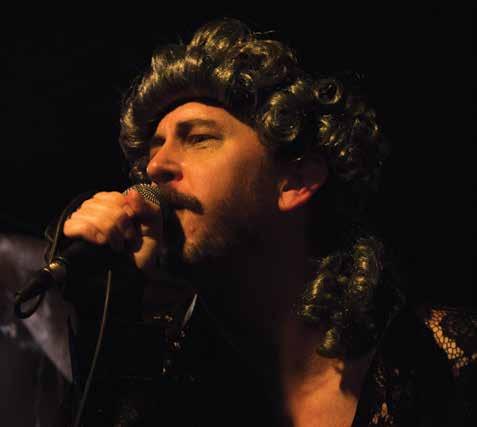
Apricot Blush was a complete 180-degree turn around. While they could be described as remnant of lo-fi acts like Neutral Milk Hotel, the band’s unique brand of indie rock is best left matchless. Led by Jackson Wise, the group has quickly become a well-known unit out of the “Pablo Generation,” a collective of upstate bands that have become known state-wide. Backed by acoustic guitars, a horn section and the haunting effects of a singing saw, Wise successfully lays out all emotions on the stage; his fervent vocals subside with the music, creating waves of feeling within every song.
On the next stage, what psych-rock trio Space Coke lacked in heartfelt yearning, they made up for with displays of their sheer power as musicians. Led by frontman Reno Gooch, the band wears their influences on their tattooed-sleeves, but it’s their showmanship and musical technique that ultimately makes you want to stay for the entire set. Their music is exactly what you think of when someone mentions the words “psychedelic rock,” and the force of songs like “L’appel Du Vide” engulf you. At one point during a turbulent guitar solo, Reno picked up his bottle of Pabst Blue Ribbon and took a 20-second swig, the continuity of the music completely unbothered. It was unadulterated rock and roll at it’s finest.
I’d only ever heard of Boohag through friends and Facebook events, always planning to go to one of their shows but never having the time, as is custom for many college students. While listening to the band on Spotify seemed like a good predecessor to the show, it hardly compared to seeing the group perform at Hunter-Gatherer. Incorporating the group’s New Orleans and lowcountry South Carolina roots, the performance is both raw and mystical, at times feeling almost like a sacrifice more than a rock and roll show. Singer and guitarist Saul Seibert, a New Orleans native who moved to Columbia five years ago, howls into the microphone over primitive drums a-la Scott Tempo, who hails from Charleston. The group has recently brought in Thomas Hammond
“theband’ s unique brandofindie
to the lineup, who cuts reverb-laced saxophone into the hard-pushing mysticism. When Seibert sings songs like “Monster” he stares into the distance, beyond the crowd, as though his sight has been temporarily blurred by something we cannot see. When he wails and croons about visions and voodoo, he makes you believe that you are witnessing something otherworldly.
The verdict is simple: Columbia, in its own strange world in the heart of South Carolina, is now proving itself to be an ambitious collective hub for local music. The sense of community at Music Crawl could be felt everywhere, whether you were standing in the crowd for a set, waiting at the bar for a beer, or bumming a cig from someone in the venue line. It’s something uniquely special to Columbia, something uniquely beguiling and uniquely human. It’s something that I regret waiting so long to see for myself.
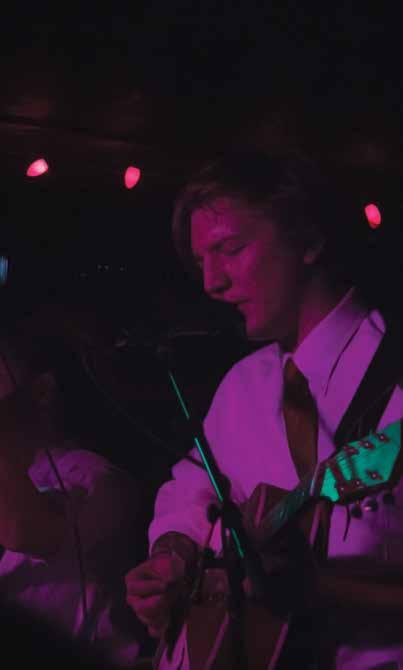
rock is best left matchless”



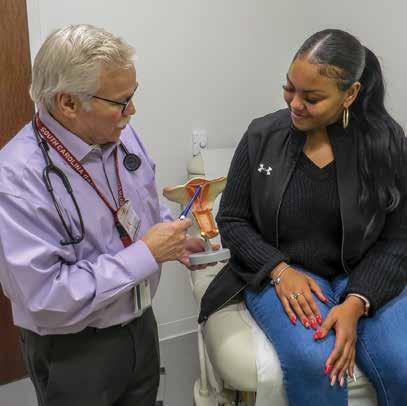


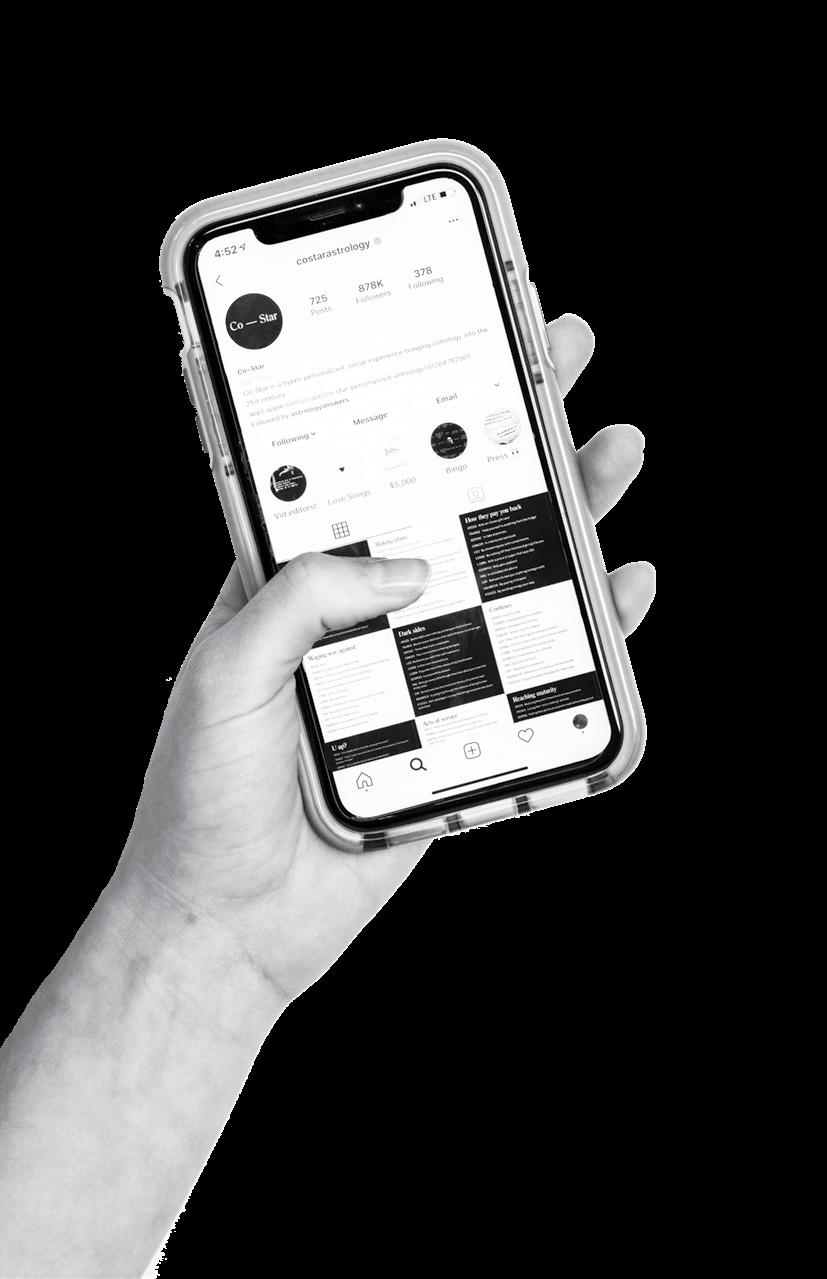
In the process of all our industry killing, millenials have also managed to bring a lot of things back. Mom jeans. Polaroid cameras. Winona Ryder. All mostly a product of a veer towards the nostalgic, but some trends have roots that go much, much farther into the past than boom boxes and tie-dye. If you’re on social media, it’s likely that you’ve seen posts with titles like “The Signs as Classic Movie Stars” or “The Signs as Characters from The Office” or even “The Signs as Scented Hand Soaps.” The “signs” they’re referencing are the twelve signs of the zodiac. Once restricted to niche Tumblr blogs and the pages of Cosmo, astrology-related content has spread like wildfire into the mainstream. You can find articles about how to dress like a Pisces or buy lipstick with Aquarius-themed packaging. You can compare yours and a friend’s astrological compatibility down to minute details with just a simple web search. Though this isn’t the first time the zodiac has gained widespread attention, the life it has found in the age of the internet is something totally new that speaks volumes about the current generation. Though astrology isn’t a science, there’s research on it dating back to ancient Greek and Babylonian studies of astronomy. It reached high expansion and popularity in Renaissance Italy, where anyone who was anyone spent lots of time studying and becoming familiar with their astrological birth chart. There were even government positions for experienced astrologers, who used their knowledge to advise rulers and statesmen, making predictions on the outcomes of political activity, trade agreements and more. Even figures like Johannes Kepler and Copernicus, seen as figures instrumental in proving astrology to be pseudoscience, studied and developed it as a field. The zodiac itself is an actual, measurable area of sky in which the sun appears to orbit over the course of a year when viewed from Earth. It’s here you find the constellations of Aries, Gemini, Sagittarius and the rest, all falling between 30 degrees of celestial latitude. Your zodiac sign is the 30 degree section the sun occupies the date, time, and place of your birth. This is the sign you probably know, your sun sign, the one you apply to those “The Signs as...” memes. If boiling an entire person down to just a bundle of traits supposedly brought on by the position of the sun and one of twelve assortments of stars sounds flawed to you, it’s because of course it does.
While relying on just your sun sign makes for an easy magazine column, you really need a lot more information. You need the date, place, and exact time of your birth for a “real,” full, astrological profile or birth chart. Making one is easy, you can just go to sites like astrology.com or download apps like Costar, put in the important information, and voila. You can see where you fall in relation to not just your sun sign, but all the signs. The planets, too. But that’s where the easy part ends, because then comes how you interpret it. All those placements matter and mean different things in different arrangement. Bottom line: It’s crazy complicated. This goes strongly against the stereotypical picture of an “astrology person.” The further I fell down the rabbit hole with my research, the more I saw that it isn’t just taking whatever the back page of the newspaper says about Leos as gospel. A popular phrase I found across astrology blogs was “it’s real but it’s not.” So to get a better idea of how “real” astrology works and how people use it, I reached out to Kenia Romero, a Psychology major at Warren Wilson College and an old friend. She talks about astrology a lot and in-depth on her social media, so I decided hers would be a good brain to pick.
“Being a psychology major, I’m very interested in how people think,” she told me. “To me, astrology is just another tool to gain that kind of understanding.”For her, astrology functions more as a tool and guide for introspection. It isn’t a religion or belief system, she told me. It’s a lense through which to view yourself and the world, a way to view yourself from a different perspective. She’s been studying it for about a year now and keeps a journal on the subject. “There’s so much you need to know,” she said, “Math, mythology, astronomy, history. This is a study you can learn from for the rest of your life.”In a way, astrology was tailor-made for Millennials and Gen Z. Ours is an era that looks backward and forward, one that exists in a buffer zone between hope and cynicism. Maybe the reason we find a draw towards things like astrology is because it, too, lives in that zone. It’s bothscience and superstition. It’s ancient but also forward-looking. It’s a paradox but it’s also a relief that, in a time of such strong polarization, you can look to the stars and feel comfortable in a space that’s grey.


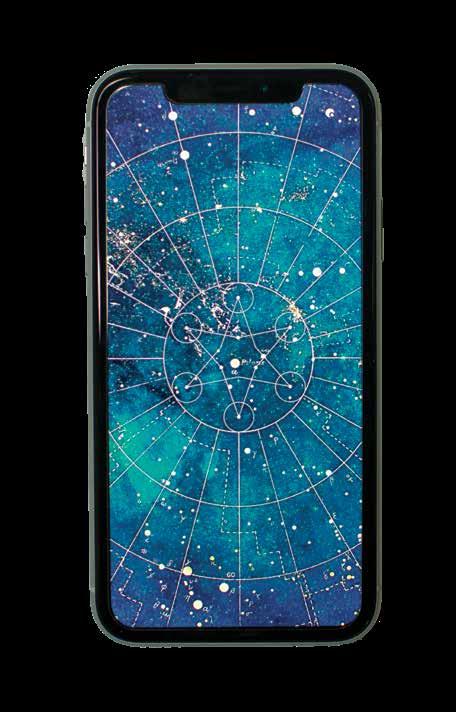





when the night is long and you start to forget what it feels like to be together look at the moon and think of me.
let the moonlight shining next to you remind you that i’m here even if i’m living a sun away and the stars aren’t clear yet in my afternoon sky i’m remembering what they looked like when we stood under them when you miss me and you start to forget how i bite my lips in a smile when you tease me look at the moon and think of me.
let the waves pull you deeper into thought and remind you that i would push and pull the tides until your coast is on my coast and all that lies in front of us is white sand and tiptoed kisses look at the moon and think of me;
if you never look at the water we’ll never know if it washes away our names
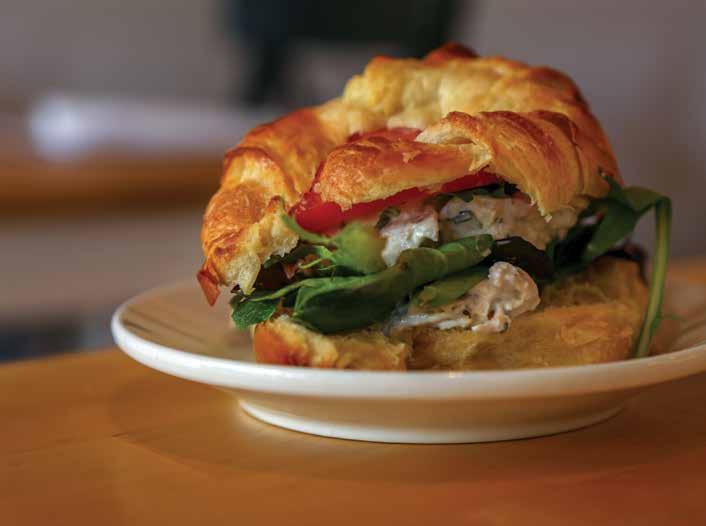
 Jessica Shillato’s perspective on the Columbia culinary scene
DESIGN BY OLIVIA
Jessica Shillato’s perspective on the Columbia culinary scene
DESIGN BY OLIVIA
Jessica Shillato, executive chef of Spotted Salamander Café, knows a thing or two about the Southern culinary industry.
“I come from a family of cooks,” she says, “they were always experimenwting in the kitchen, and that’s really how I got my start in the industry.” Eventually a graduate of Johnson and Wales culinary school, Shillato started as a waitress, then “gravitated to the kitchen”. After graduating and building experience, she founded Spotted Salamander, now a Columbia local’s staple.
In January of 2019, Shillato was selected as one of South Carolina’s 5 Chef Ambassadors, representing the state with her culinary work. This honor allows selected chefs to share and showcase the diversity and beauty of South Carolina’s food scene at various events across the state. Other chefs nominated include Mark Collins of CIRCA 1886 in Charleston, Tania Harris of Greenville’s The Lazy Goat, Brandon Carter of FARM in Bluffton, and Kelly Vogelheim of Town Hall in Florence.


Gender is a topic often discussed in the male-dominated world of executive chefs.
Shillato, however, takes it in stride. She says: “I never really let it bother me, but if I’m in a large group with many levels of cooks, newer cooks’ questions will always go to the male, executive chefs, who often ask me for the answer.” She comments that she’s had cooks walk out on their first day, saying they “won’t work for a lady chef.”
Ingredients: the genesis of a chef’s creative process, where the magic begins. “I always start by shopping for ingredients,” she says, “if I find something I’ve never worked with, I always want to figure out a pairing of flavors for it.” Most Columbians will instantly correlate farmer’s markets with the famous Soda City Market, but Shillato digs a little deeper. She says, “the Forest Acres Market is my favorite place to go, it’s small, organic, and made up of the beds of farmers’ pick-up trucks.” On the subject of ingredients, Shillato finds that the cultural phenomena that is avocado toast “is so overrated, I don’t get it at all.” She instead hopes to see a “return to the classics that have been so integral, but forgotten about.”
Ingredients: the genesis of a chef’s creative process, where the magic begins.
The idea of the “New South” has especially risen in the world of gastronomy. According to Columbia’s scene in particular, Shillato says that Southern restaurants were previously and infamously known for “opening a can and heating it up.” However, she says that “it has gotten so much better. Now there’s this focus on freshness and the local farmer, and there are some really brave new restaurants coming up all around The South.”

Everybody knows Spotted Salamander by its deviled eggs du jour, daily cronuts, and the seasonally short-lived soft-shell crab, but what gives the café its very specific feeling and flair? “It’s fresh and ever-changing,” says Shillato, “it’s rare that you will see the same thing twice, and if you do, it’s because it’s a favorite of returning customers”, like the classic tomato sandwich, pork belly mac and cheese, and the café’s “Fried Chicken Friday.” “Focusing on our local farms is so important, and working with the seasons adds so much sincerity to the food.”

“Focusing on our local farms is so imporant, and working with the seasons adds so much sincerity to the food.”
Shillato knows that her journey to her current state is worth the climb when she thinks about the relationships built along the way. “The mentorship is what makes me so happy,” Shillato says, with a smile in her voice, “everyone is always growing. I have employees here who have been working for me since we opened the café; one who started as a dishwasher recently became the main cook.” The narrative of teaching one another is extremely prevalent to her, tying back to the familial roots in the home kitchen. She says, “it’s so awesome to teach people, and so important to let them know that they can always be better, always grow, and always learn.”
“We have just started with the plans for a new restaurant, so it’ll probably be a few months until everything is put together.” Her vision for the upcoming establishment is still
in the works, she goes on to say: “I want to do dinner, but it won’t be as ‘nice’ as Terra or Motor Supply Company. I want people to be able to come in every day if they like, and feel happy and not go broke.” Fans of her maiden voyage shouldn’t be worried though, she assures, “I know it’s going to be really good Southern food, and I’ll use some of the same classic flavors, but the details are undecided.” With Shillato’s dedication to fresh flavors and classic pairings, it’s sure to be a hit.
Spotted Salamander Café and Catering can be found on 1531 Richland St, open Monday through Friday from 11:00 AM to 2:30 PM. They can be reached for questions or catering requests at (803) 556-2197, or at spottedsalamandercatering.com






 BY CASSIDY SPENCER • DESIGN & ILLUSTRATION BY MEAGAN HORRES
BY CASSIDY SPENCER • DESIGN & ILLUSTRATION BY MEAGAN HORRES
There is a NASA-esque office in the sky. And there are dials and switches and big levers, and very focused people with the top button of their white button-up shirts undone, and they are looking over papers and looking at their watch sometimes, and pushing up their glasses and sighing under their breath. The room is mostly stainless steel, humming with ringaling!s and clickclickclickclacks and ThatWasn’tTheProposalWeDiscusseds. Cheryl in management likes Elliot, who has had a steady girlfriend since he started working there, but that’s beside the point.
In the front of the room, with all the rows of long futuristic stainless steel panel desks facing it, there is a big screen. Playing on the screen is something called the RealTime People Gauge (RTPG for short). The RealTime People Gauge is playing 100% of the time. These employees work 100% of the time, if I can even call them employees, and if I can even reference time in relation to the NASA Office In The Sky. If we were to watch the RTPG program at any moment, we would become very confused, and our tiny tiny brains of this earth would eventually lose interest, and we would start wondering about what we will have for dinner tonight; because
of people are smiling gently at him, patting his shoulder softly when they pass by his rolly chair, raising their coffee cups in silent congratulatory cheers when he makes eye contact with them across the room. I don’t know how to put this gently, and I’ve sat long enough here thinking of how to tell you, so I think I will just come out and tell you, that Oliver’s earth happens to be the one that we live on. He engineered this one because he thought it could work. At the end of everybody’s life we all have ideas for this or that detail about the world that we think oughta change. Most people let go of that bygone once they are presented with the opportunity to see every being they’ve ever loved or admired collected into one expanse of multiplicitous joy for all of eternity. Oliver did not.
Neither did the rest of the workers in the NASA Office In The Sky. They figured that if they could manage their own version of it all, that with enough tweaking and enough circumstances being ‘guided’ by ‘fate’, they could create a world that made the inhabitants happy. At least more happy, I guess, than they’d been in their own previous living experience. Some people, naturally, don’t realize how much of an undertaking


help with group projects in grade school, but their name was on the final thing anyway, and they got away with it every time because nobody wanted to make a big fuss. Oliver was not one of those kinds of people. He was the one writing the bulk of the paper, signing everyone’s name, and refraining from the big fuss. Oliver did not like a big fuss. Oliver hoped that his coworkers would not make a big fuss over his appearance on the RTPG today (they got Lance a cake last time he got on, which felt a lot like a big fuss to Oliver), but thankfully, everybody seems to have resigned themselves to these miniature silent sentiments of congratulations.
Cause, see, nobody thought Oliver’s world was going to work. Everybody thought it was the most bizarre and self-destructive tweak that could be made. A lot of people flounce into the office with big ideas of “Less Clouds!” or “More flowers!” or “Clean water everywhere!” but in those worlds people just got really bad sunburns or they had eternal debilitating allergies or they had to build an ark. In Oliver’s world, he decided to tweak
love, which always freaks people out when he tells them, because to mess with the chemistry of love you have to send in an extra set of forms and wait for them to come back. But he did.

In Oliver’s world, when you fall in love with somebody, they don’t have to fall in love with you back. Everybody thought that was downright crazy. But, hey, here we are, and sure we might have a lot more sad love songs than happy ones, but today we got on the RTPG, so I guess it isn’t all so bad, and I guess maybe Oliver did a pretty bangup job after all.

“In Oliver’s world, when you fall in love with somebody they don’t have to fall in love with you back.”
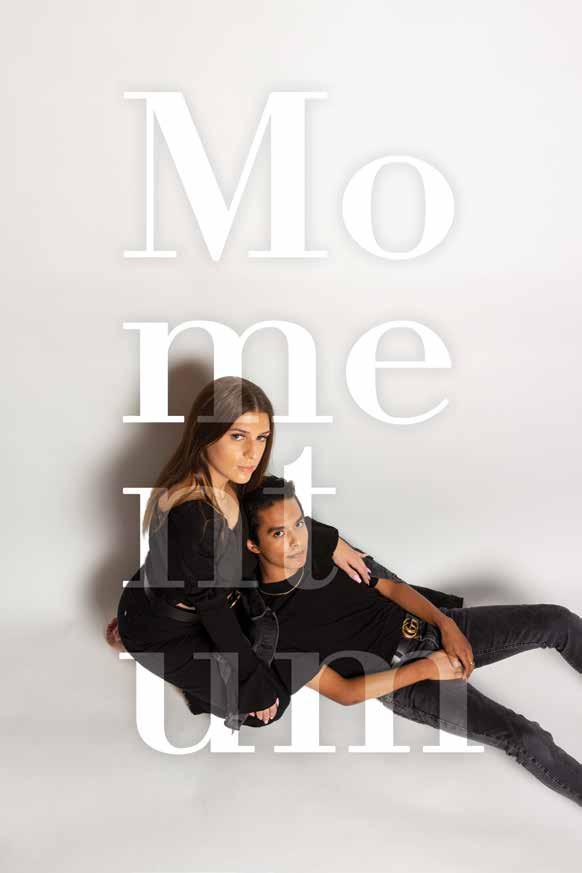
This season we're throwing away all of our skinny jeans to achieve this oversized denim look. Rather - mom, flared, straight leg or cropped. This season we are bringing fresh new evergreen denim wear. Winter of 2019 is providing a blance of masculine and feminine silhouettes paired with vintage washes. This gives a comfortable tomboy feel with a twist that will pair with any personality, color, body shape, or size. Denim is back and we're here for it!
STYLED BY JASMINE WHITE • PHOTOS BY MARK MADDALONI, COLEMAN ROJAHN, ALYSSA WILLEY • DESIGN BY MEREDITH PRICE MODELS: EVA MCDONALD & LENIN VAZQUEZALL DENIM : Denim Jacket, Wildflower $62
Denim Wide Leg Pant, Vesitque $72

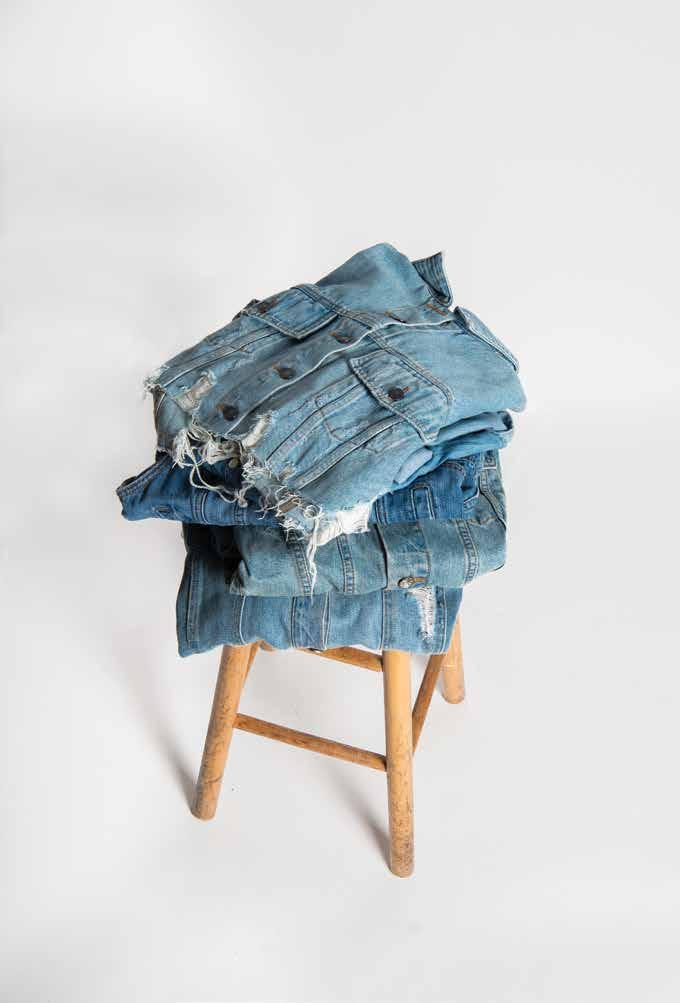
 ALL BLACK DENIM: Black Jacket, Wildflower
$58 | Black Gucci Belt
ALL BLACK DENIM: Black Jacket, Wildflower
$58 | Black Gucci Belt


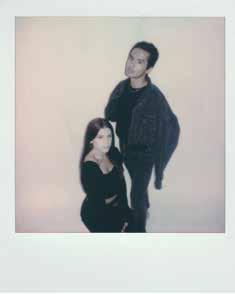





 ALL DENIM : Denim Vest, Sid Nancy $14 | Denim Button Down, Sid Nancy $15
ALL DENIM : Denim Vest, Sid Nancy $14 | Denim Button Down, Sid Nancy $15




 DENIM & BLACK: Black Mesh Shirt, Wildflower $36 Denim Vest, Sid Nancy $14
DENIM & BLACK: Black Mesh Shirt, Wildflower $36 Denim Vest, Sid Nancy $14

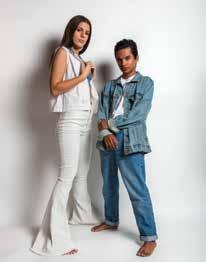
 DENIM & WHITE: Denim White Pants, Vestique $64 | Denim White Vest, SidNancy $12
ALL BLACK DENIM: Jet Black Jeans, Vestique $50 | Black Puffy Sleeve Shirt, Wildflower $38 | Black Gucci Belt
DENIM & WHITE: Denim White Pants, Vestique $64 | Denim White Vest, SidNancy $12
ALL BLACK DENIM: Jet Black Jeans, Vestique $50 | Black Puffy Sleeve Shirt, Wildflower $38 | Black Gucci Belt
 BY HALLIE HAYES • PHOTOS BY ALEXANDER WYATT • DESIGN BY MEAGAN HORRES
BY HALLIE HAYES • PHOTOS BY ALEXANDER WYATT • DESIGN BY MEAGAN HORRES
It’s not always easy turning our hardships into something others can prosper from. When unexpected incidents occur and we are left to either grow or give up, a lot of times we choose the easier option: give up. However, this was not the case for 23-year-old entrepreneur and CEO of Maven Therapy, Miguel Velert.
In 2011, a mere freshman in the shark tank that we call high school, Miguel was in an accident. An avid skier, he broke his back after a nasty fall during a skiing trip in West Virginia, leaving him paralyzed from the waist down. Immediately following the accident, Miguel only had full control of his left arm, resulting in him using an electric wheelchair. He wanted to become independent again, but struggled to know how—until his father, alongside an engineer, developed a machine that would change everything.
It was completed in 2013—an exercise machine that Miguel could use when he no longer had physical therapy. After using the machine for a year, he developed complete control of his left arm again and began using a manual wheelchair, a big step towards his desire to once again become independent.

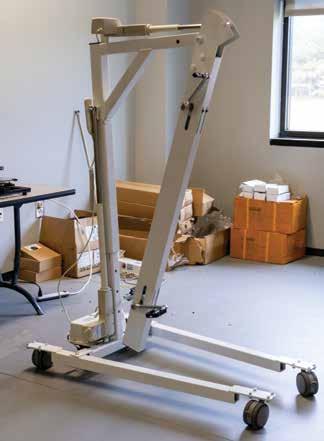
His life was, once again, changing. This time, however, it was a change that he had waited for. It was a change that he wanted others in his situation to experience. “We saw the potential of this device when we saw how much it had helped me; not only to regain movement in my arm, but also to recover and be able to live an independent
life,” Miguel says.
And that’s when it happened. Miguel decided to make what had played such a major role in his life a business, in hopes that it would also reach the lives of others. At just 23 years old, Miguel is a young entrepreneur, becoming CEO of his own company—Maven Therapy.
“Maven Therapy is a medical device company I started in 2018 with my father (Miguel Velert, Vice President and head manufacturer of Maven Therapy) and our longtime friend and business partner Christopher Braddock (Maven Therapy, CFO),” Miguel says. “We are designing an exercise machine for people who have limited mobility disabilities or conditions that make conventional range of motion exercises difficult.”
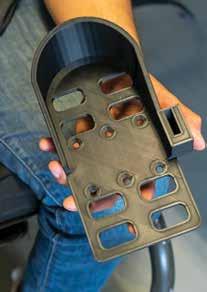
The company name came from the combination of three things. Miguel’s initials are “MAV,” which initially got his brain creating ideas. A friend of his father then suggested Maven, due to Miguel’s initials and the definition of Maven—a person who is an expert at something. However, the deciding factor was, well, as Miguel says, “It just sounds cool.”
Miguel admits that being a young entrepreneur isn’t easy. There was a lot of planning and realistic issues to consider, like funding.
“Starting Maven was a slow process. Not only were we still working full time jobs and going to school, but we also did not have
“We believe movement is critical to a patient’s recovery and health.”
adequate funding to start a new business,” Miguel explains. “We became an official LLC in the state of South Carolina April of 2018. In the fall of 2018, we became a client company of the South Carolina Research Authority (SCRA). With them, we were able to secure initial funding for an office and workspace to develop new prototypes and begin talks with various rehab hospitals to try out our device.”
Miguel and his partners never stopped believing in the project. Even with his focus on being a full-time student, this young entrepreneur never doubted the success that Maven Therapy could be. Though there are still major plans for growth with the company, the past 18 months has offered a lot for Maven.
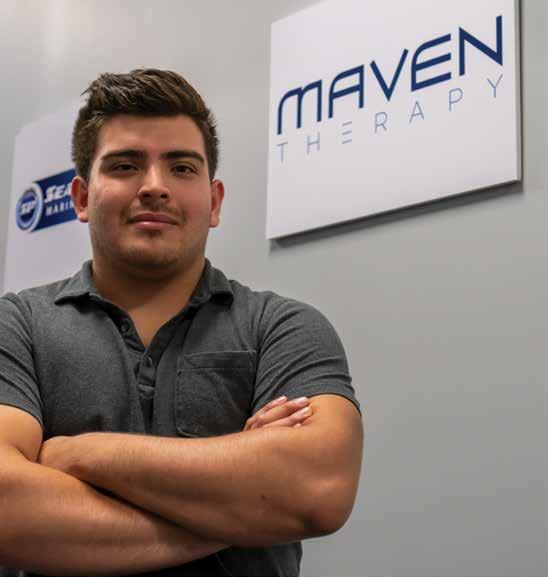
“Maven has grown from a side project in a shed in our backyard, to a job with a workspace and strategic partners and investors. We have worked on Maven for about four years and in the year since we officially started, we have grown more than the previous three years combined. We have a notice of allowance on our patent application, and we are in the middle of testing our device. We aren’t done yet, but
this year has seen a lot of growth for Maven Therapy,” Miguel says.
As college students, it can be easy to overlook the potential and possibility of creating a start-up, and succeeding with it at such a young age. Miguel, however, consistently allowed the passion provoking inside of him push through.
“The biggest challenge with being a young entrepreneur, any entrepreneur really, is that there is no manual to being one,” Miguel says. “There isn’t a class you can take that teaches you to be an entrepreneur. It’s a big learning experience. You need to be dedicated to working on something you’re passionate about even if the rewards aren’t immediately seen.”
But it’s the reason behind this company that means the most to Miguel. He didn’t choose to create Maven for himself, he chose to create it for those surrounding him. “We started Maven Therapy on the premise of enriching the lives of people who have injuries or conditions that limit their mobility. We believe movement is critical to a patient’s recovery and health; it’s in our mission statement. We designed a device that is easy
to use, not only for a patient but also for therapists and caregivers,” Miguel explains.
The future for this company seems bright. With goals of seeing his device used in clinics, facilities and homes across the United States, Miguel continues to dream for his company and for the creation of practical exercise equipment to impact those going through what he has been through.
More importantly, Miguel dreams for those who will use this machine. He knows its impacts, and he hope that new users will have the opportunity to discover them.
“As a business owner, I believe you need to have an innate desire to make a difference and impact in your community and people in that community. I want to help people, but more than that, I want to show people who are in the situation I was once in, that it is possible to recover and be independent again.”
For more information on Maven Therapy, visit maventherapysc.com
“Miguel decided to make what had played such a major role in his life a business, in hopes that it would also reach the lives of others.”
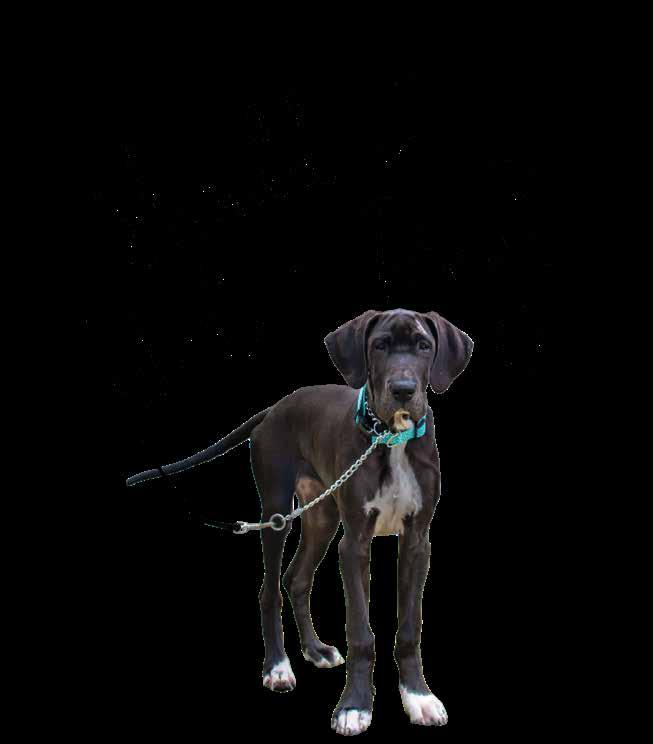 BY CAROLINE FAIREY • PHOTOS BY ALYSSA RASP DESIGN BY EMILY SCHOONOVER
BY CAROLINE FAIREY • PHOTOS BY ALYSSA RASP DESIGN BY EMILY SCHOONOVER
You’ve asked yourself this question before. At your busiest, maybe, studying for three exams and writing two papers: I wish I could cuddle up to my dog right now. Or a tranquil fall afternoon on the Horseshoe: That student looks so happy walking their dog. How hard could it be? Between Dogs on Davis, the Center for Health and Well-Being’s canine employee, and the recently adopted dogs working in the Honors College, it’s clear that the university endorses a little pet therapy to solve the stresses of college life. But before you believe the hype, the three students (and one veterinarian) below have some advice to pass on. These are people who really love dogs—and part of loving dogs, they know, is questioning whether you can truly give them what they need to thrive.
The following stories are close-to-direct transcriptions, lightly edited for clarity and concision.
I adopted Cola from a local shelter when he was around 8 months old. He was pretty trained when I got him. He was dog-friendly and people-friendly; we didn’t know about cats, but turns out he likes cats, too. I did enroll him in a training course. I was able to afford it, but some people can’t. He did one at PetSmart, which cost a little over 100 [dollars], which is actually one of the cheaper options.
I was not spontaneous before, but I’ve lost any sense of spontaneity now. If I want to do something, I have to find someone to watch him or make sure Cola can be in his cage that long.
One day, coming home from class, there was blood and poop splattered all over my walls and floors. He had to have emergency bloodwork done. He ended up having an upper GI infection, which cost me over $250.
I purposely plan my classes to be back-toback and in the middle of the day. I wake up around 6—that way I can feed him, walk him, then play a little bit before he gets in his cage. Saturdays are the hardest because I’m in band, so I’m gone all day long. I usually contact friends to watch him and pay them what I can.
My parents were 100% against me getting this dog, so I’ve been totally on my own.
Every morning, though, Cola wakes me up by laying on top of me and licking all over my face. He’s just a genuinely happy dog. And for me, that’s worth it in the end. He’s a good boy.
My roommate had a friend whose brother’s roommate found Breezy. In Greenville, he came across this dog getting hit with a stick on the street. Basically, he pulled this weird form of vigilante justice, knocked the guy out with his longboard, and brought her back to his dorm. There was no way Breezy could stay there.
I had really wanted a dog who needed a home, not a random dog. I wanted a mutually beneficial relationship. I remember my roommate and I charting out a schedule in our agendas, then walking to each room in the apartment, asking each roommate, “What if we got a dog?”
In retrospect, we had no idea—it should have taken a lot more consideration. Anyone who is thinking about getting a dog: Have a full week where you sit down at the end of the day and say, “When would I have taken a dog out today? How much time would I have spent with her? Did I have money to get her food?”
But then my roommate and I drove to Greenville two days later. We brought her home for what we said would be a trial period, and what ended up being all of us immediately falling in love with her.
The shift was spring break. I left for a weekend and she stayed out at a friend’s parents’ lakehouse. When I came to get her, she was jumping up and down, so excited to see me, but also started nipping at my shoes and sleeves.
The next morning, we went on a walk to the baseball field in our neighborhood where I let her off the leash to play fetch like we did every morning. She got distracted by these construction workers and I just saw her eyes change. It was this immediate thing. She bit onto my wrist, shaking it around, and as I pulled it away, she ripped my sweater clear off my body.
After that, we’d have to pin her to the ground and loop the leash through her mouth coming home from walks. I was covered in bruises for weeks. It stopped being playful.
It was like a mini dog attack every time. I stopped going on walks alone. Someone would have to come with me, which ended up affecting all of my roommates’ sleep schedules.


It didn’t matter how much exercise we got her. For some dogs, that trauma is just so ingrained that there’s just nothing you can do.
Training would have been astronomical—$3000 for the least expensive one geared toward aggressive dogs. Most programs stated on the website: for some dogs, this might not work. Imagine my life savings, some of my parent’s savings, spent on training that didn’t work, and then back to square one. It felt like we were out of options very quickly.
We knew she had puppies. Her ears were clipped, so she was likely a breeder for fight dogs; maybe she even got fought. She was a pit mix, so we can only assume. But she was so sweet. She never acted up in the apartment. I slept in bed with her every night. We’d do little flower crown photoshoots. She was so gentle; she never barked. I don’t know what her bark sounded like. And she liked to sit right on you, climb into your lap and cuddle.
It was so hard to even tell people. We lived through it for weeks, even months, because she was a good dog. That was the root of it. She was a good dog who had trauma. Like, fine, I’m bruised and scared to take her on walks—that’s one part of her. I just can only imagine what she went through.
I think that there is a necessary humility in realizing that you can’t just take any dog. Serious training goes into being able to take care of a dog like Breezy. I was so against the idea of just getting some pretty dog for Instagram that I was like, “I’ll just take a dog who needs me,” but you have to think about what you can give that dog. When I get a dog after college, I won’t go into it with this dogsavior complex, this idea that I can help any dog, no matter what they’ve been through, because that’s not a reality, especially for college students.
Senior, Public Health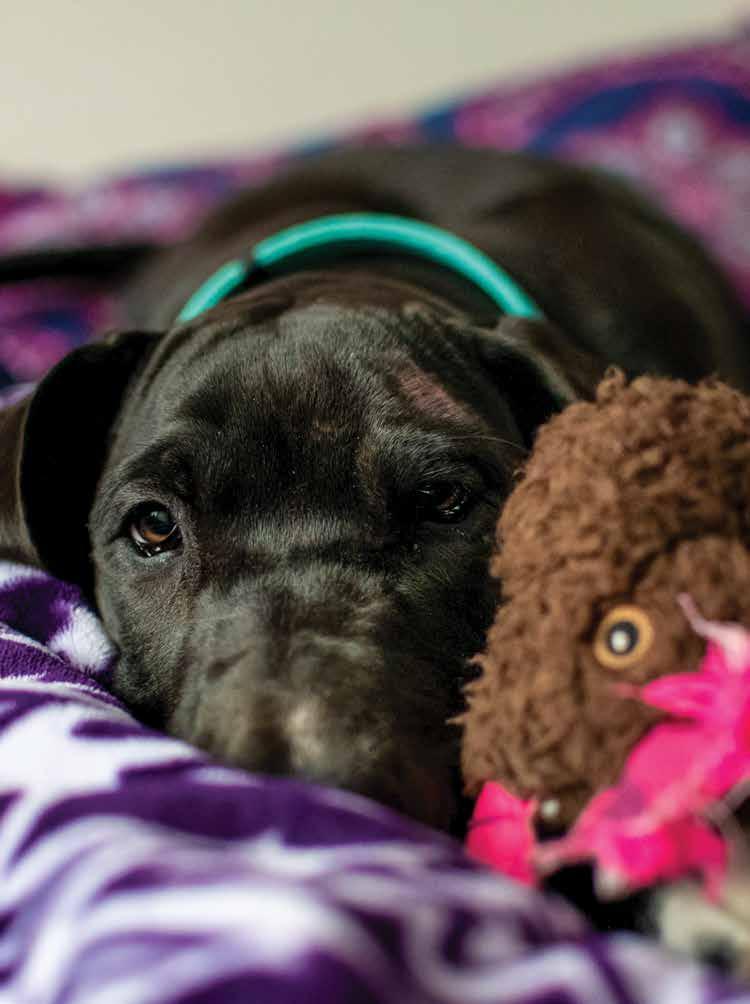

I worked at PetsInc, a local privately-owned nonprofit rescue, for two and a half years. Basically what we do is we take in animals, we give them all the medical stuff they might need, and we adopt them back out to the public. I was an adoption counselor for most of my time there.
The students who came in to adopt a dog usually wanted a puppy; if they expressed interest, I had to explain to them that puppies are a ton of work—they poop everywhere, they eat things they shouldn’t, and you have to be able to take them outside every two hours, which I know during my college experience wouldn’t have worked.
PetsInc has a new rule that you need to be over 21 to adopt. Before I started working, a bunch of people had come in and adopted animals throughout the semester and summer. Right as the semester ended, we got dozens of calls saying, “I’m going home to Michigan,” or “I’m moving, I can’t take this dog with me.” That season, we ended up having over 100
animals returned.
They must have thought they were buying a sweater. A dog isn’t something you can just return.
For example, this one senior girl came in and wanted to adopt a puppy. I sat down with her and asked her to tell me about her living situation. What happens if this puppy chews up your rental and you have to pay to get it fixed? What if you land your dream job and it’s out of the country or state? And she was like, I can’t say what would happen. This time for college student is so transitional; it’s hard to keep something as consistent as an animal. There are people who’ve been able to do it successfully, but for most of us, it’s not going to happen.
Make sure you have enough time for your dog, especially at first. The first three weeks of owning an animal is critical. If there’s no one there to make sure (a) it’s not getting into trouble and (b) making sure its settling into its new environment, then it’s going to set you up for failure. Have a lot of patience—no matter what age animal you get, shit’s going to happen.
The financial aspect is always the one thing students are unprepared for. A dog is an incredible, life-long financial responsibility. The puppy series of vaccines includes four exams, vaccines, fecal checks, heart worm and flea prevention. Then you need to get the puppy spayed or neutered and pay for exams, vaccines, and bloodwork every year. Not to mention the potential for unexpected costs, such as intestinal blockages, injuries, sickness like kennel cough from going to the dog park. The list is endless. You can't expect your dog to never need veterinary care and you should have a savings plan in place in case something happens.
[Veterinary] services are undervalued. People are constantly seeking out "cheaper" options. The problem with a cheaper option is when you cut costs you are also cutting the quality of medicine and services provided.
I think that college students really do love their animals and want the best for them,

whether they are truly able to provide that for them or not. I think students try their hardest when I ask them to do things at home to help with their pet's care, like soaking a wound a home twice daily. It is usually asking for them to spend extra money they weren't expecting that is the issue (unless they can call mom or dad for help).
Puppies and kittens given as pets are at the highest risk for being returned to a shelter. College students have so much going on with school (and potentially jobs) that a puppy is too much of a responsibility, and possibly a distraction from what is most important. I know it looks like so much fun to have a puppy, but it's not fair to the animal if you are not able to give it to proper attention it needs. There is plenty of time to adopt a fur baby of your own; I recommend waiting until you are more settled before taking that leap. And please: adopt, adopt, adopt!
Griffin Animal Hospital




